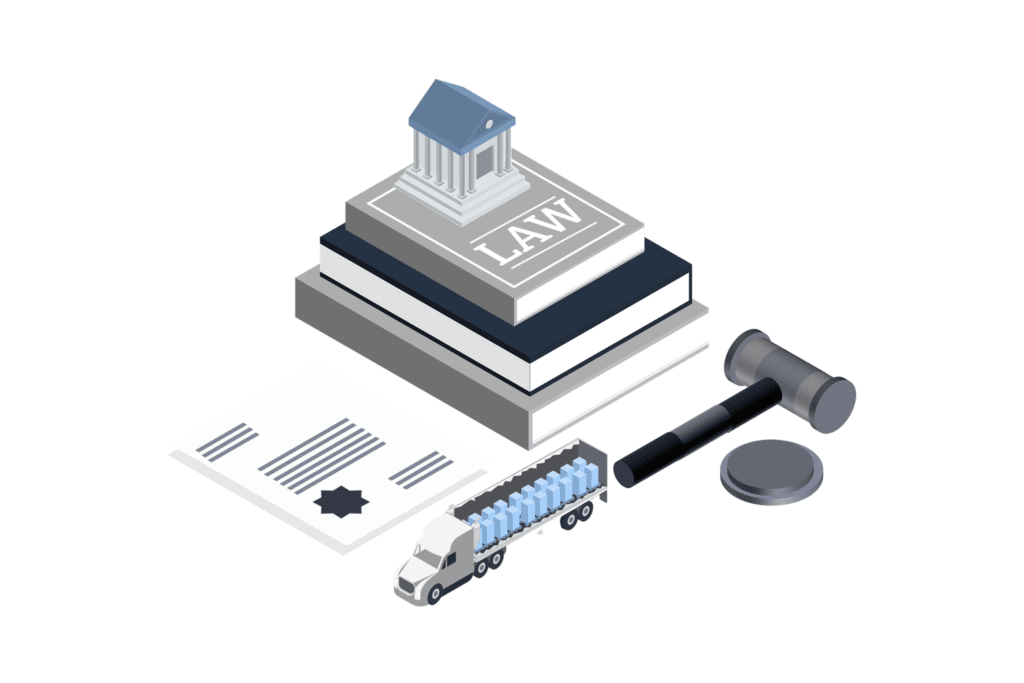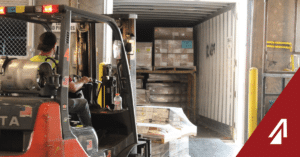Regulations are one of the largest concerns faced by the trucking industry today. On the one hand, they strive to promote health and safety for commercial drivers and other motorists, but on the other, they often increase the difficulty of trucking and reduce the available workforce. Each regulation has pros and cons, and the balance has been a challenge ever since the industry began over one hundred years ago.
These regulations challenge carriers and logistics managers constantly with not only staffing issues, but also by being changed constantly. The United States Department of Transportation and Federal Motor Carrier Safety Administration often implement new regulations or deregulate old regulations and it is imperative that those in the logistics industry stay up-to-date on current regulations. The full extent of the trucking industry regulations can be found on either the Electronic Code of Federal Regulations or the Federal Motor Carrier Safety Administration websites, but the most pressing regulations of 2019 can be found here.
ELDs
The electronic logging device (ELD) mandate has been making the news since it was first announced in December 2015. At that time, drivers were warned of the upcoming implementation date in December 2017 and were encouraged to switch from paper log books to the electronic logging devices. Certain bad actors in the trucking industry would cheat on their hours of service logs and push to deliver loads “after hours”. Shippers became accustomed to the speed and efficiency of the deliveries and began planning their supply chains accordingly. Since December 17, 2017, the mandate has been fully implemented and these bad actors are more susceptible to being caught by law enforcement. However, as the ELD use becomes mandatory in December 2019, trucking regulation experts continue to debate whether or not ELDs have had a positive influence on the industry.
Pros:
• ELD regulations provide for the safety and wellbeing of both commercial freight drivers and other drivers on the road.
• Drivers are forced to take their hours of service requirements seriously or meet serious consequences.
• ELDs cause shippers and carriers to work more efficiently and perfect their planning strategies.
• They help shippers and carriers to work closer together on pickup and delivery times and locations.
Cons:
• Removing bad actors has cut shipment productivity by approximately 3-8%.
• The regulation provides rigid standards that many upstanding drivers struggle to meet. Often, drivers get in trouble with detention at loading and unloading – reducing their available drive time and limiting their wages.
• Many drivers saw the implementation of the ELD mandate as the perfect retirement opportunity and left the industry altogether.
Currently, trucking organizations like ATRI and ATA are studying the effects of the ELD mandate. They will take their findings to the USDOT and FMCSA for them to evaluate the mandate and determine its future.
Hours of Service Reforms
Since the 1930s, hours of service (HOS) regulations have been a part of the trucking industry. Originally meant to ensure driver safety, many feel these regulations have become too rigid and often do not regard drivers’ actual needs. Many experts feel this law treats each driver as if they were identical as opposed to being unique and having individualized needs.
Current regulations state that drivers may operate a vehicle for 14 hours per day with only 11 consecutive hours of drive time. Drivers must take a 30 minute break after 8 hours of consecutive driving. After their 14 hours, they must take 10 consecutive hours off, and they cannot exceed 60 out of every 70 hours. Lastly, after seven working days they must take a 34 hour reset break.
Problems drivers have with ELDs often stem from problems they have with HOS regulations. The issue is that many drivers are not able to make full use of their days due to downtimes like detention, traffic jams, or adverse weather. When they cannot drive as much, they cannot earn as much. In 2019, the trucking industry is working with USDOT and FMCSA to reform and revise the HOS requirements to work better for drivers.
Some of the changes include:
• Expanding shorthaul exemptions to mirror longhaul drivers.
• Expanding 14 hour limit by up to two hours when a driver encounters adverse driving conditions.
• Removing the “30 Minute Rule” where drivers must break for 30 minutes after driving 8 hours.
• Reinstating the option to split berthing times.
The most prominent change will be to the berthing regulation. Currently, drivers must spend eight hours in their sleeper cabs and can spend an additional two not operating the vehicle. Some lawmakers are interested in relaxing the rigidity of that standard to allow drivers to take split breaks and not affect their drive times. Legislation like Responsible and Effective Standards for Trucking (REST) Act would allow drivers to break a maximum of three hours during their 14 hour drive time and be able to continue driving the remainder of their 14 hours. The break would act as a pause on the driver’s clock. After the 14 hours, drivers would still need to reset for 10 hours before starting their clocks over.
Pros:
• The REST Act says that drivers have a better sense of their own bodies and should be able to rest when needed.
• Resting when necessary should not affect the daily earning potential. Drivers would be able to work their full amount of hours and still avoid congested traffic times and reduce carbon emissions.
• Drivers would be able to park more safely. With current regulations, multiple drivers get into patterns and limit availability of parking at rest stops. This causes unsafe parking and/or undue expenses parking in paid lots.
Cons:
• HOS rules are set in place to keep all drivers safe.
• If drivers are not mandated to rest then they will not rest.
• Lack of rest is a hazard to all motorists.
Lawmakers are currently debating whether or not they should allow flexibility on this issue; meanwhile ATRI and ATA are studying the current mandate and its effect on drivers.
New Minimum Age Rules
Many federal lawmakers are looking for areas to combat the limited driver market. Many ideas have been suggested and are being tested throughout the industry, but one with the most promise is the DRIVE-Safe Act. This was a bill, written in US Congress, that would reverse the Motor Carrier Act of 1935 and would allow drivers that are younger than 21 years old and have their CDL to become over the road, interstate drivers. Currently, drivers age 18-20 can drive intrastate but cannot cross state lines. A major portion of the bill specifies that underage drivers would be placed into an apprenticeship program that would test their driver skills as well as their familiarity with the vehicles and trailers that they would operate. Drivers would operate under supervision for a designated amount of time and operate on a probationary basis.
Pros:
• The influx of drivers would help with the current driver shortage crisis.
• Many younger drivers would be able to help meet the current demand and be easier to retain than older drivers.
• The 21 year old designation is seen as an arbitrary standard set nearly 100 years ago.
• Since 18-20 year olds can drive around a state now, crossing state lines should not be any different.
Cons:
• Detractors argue that 18-20 year olds are not responsible enough to operate both dangerous and valuable equipment in that setting.
• They contend the risk to other motorists is too high.
• Commercial driving insurance costs would skyrocket.
As of the time of this writing, the DRIVE-Safe Act is still in committee but lawmakers expect a resolution and vote later this year.
New Minimum Wage Rules
This year, many states and municipalities are increasing their minimum wage requirements for workers. The federally mandated minimum wage remains at $7.25 per hour, but each state or local government can impose their own local standard (the state of California’s minimum wage is different for companies with more than 25 employees – $12.00/hour, and with fewer – $11.00/hour. However, the city of San Francisco has a $15.00/hour mandate for all companies). This fluctuation of wage rates impacts many carriers and logistics managers with employees operating in many different parts of the country. Drivers are often paid by the mile, but their rate would be different depending on where they are based.
Pros:
• Wage increases are often strong incentives for recruiting or retaining drivers.
Cons:
• Wage costs are passed on to customers and end-users, making shipments more expensive.
• Customers unwilling to pay higher prices will find carriers that charge less.
• Carriers based in more expensive areas will not be able to hire as many employees.
• Companies are incentivized to move to areas with cheaper labor.
Drug Testing Requirements
This year, there are two major drug testing regulation changes. The first is the Commercial Driver’s License Drug and Alcohol Clearinghouse. This regulation states that the FMCSA is establishing a clearinghouse for drug and alcohol related offenses that employers must consult before hiring potential drivers. The clearinghouse will contain information regarding drivers’ substance abuse violations, including drug and alcohol, and must be kept up to date by employers. Any carrier looking to hire drivers must search the database before allowing employees to operate vehicles. Also, they must perform annual searches on current employees. State licensing branches must search the database as well before issuing new CDLs, transferring, renewing, or upgrading old licenses. This clearinghouse is meant to identify drivers that cannot legally operate commercial motor vehicles, safeguard employers and potential employers from dishonest behavior, and provide drivers a path to treatment, recovery, and restoration. This regulation will be fully implemented by January 2020.
The second major regulation is lobbying the FMCSA to change drug testing methods from traditional urine sampling to hair follicle testing. This method has proven to be more accurate and will last with the test subject longer than traditional sampling. This regulation, in combination with the clearinghouse will surely further reduce the available driver population.
Pros:
• The Drug and Alcohol Clearinghouse will help further remove bad actors from operating commercial vehicles
• The clearinghouse will make the roadways safer for other drivers.
• It will work to eliminate unlawful hiring.
• Provide better visibility of the current driver pool.
• The hair follicle testing will provide more accurate illicit substance testing results and help eliminate bad actors.
Cons:
• Fewer drivers will be eligible for hiring and put further stress on the market.
• Reducing driver supply and maintaining or increasing demand will cause shipment costs to further increase.
One of the reasons regulations are one of the top concerns for the trucking industry today is that many of the regulations simultaneously promote safety but limit the workforce. With a strengthening economy and greater shipping demand, more drivers are needed. Regulations like the ELD mandate and HOS rules, enforce rest requirements but discourage workers from remaining in the trucking industry by limiting drivers’ earning potential. Other regulations like the Drug and Alcohol Clearinghouse and stricter drug tests will make driving safer by helping eliminate bad actors from being permitted to operate commercial motor vehicles, but will also further reduce the number of available drivers. Solutions to the low number of drivers, like the DRIVE-Safe Act, are helping increase driver numbers, but also pose safety issues. Higher wages also encourage more drivers to seek employment but may limit the number of drivers able to be hired. Overall, regulations in the trucking industry are complicated. Each one operates with considerable pros and cons that must be carefully evaluated before implementing. That is why carriers and logistics managers must keep up-to-date with current regulations and be sure that they are in compliance.



